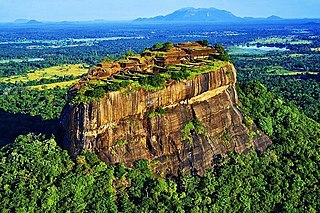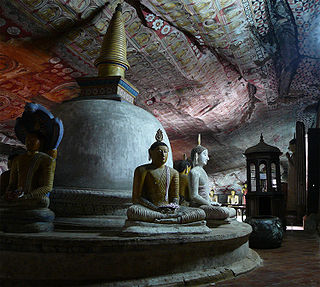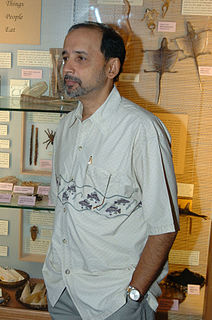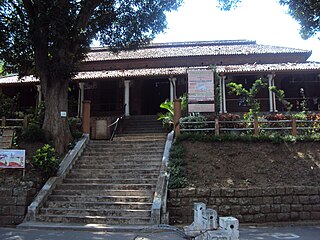Related Research Articles

Anuradhapura is a major city in Sri Lanka. It is the capital city of North Central Province, Sri Lanka and the capital of Anuradhapura District. Anuradhapura is one of the ancient capitals of Sri Lanka, famous for its well-preserved ruins of an ancient Sinhala civilisation. It was the third capital of the kingdom of Rajarata, following the kingdoms of Tambapanni and Upatissa Nuwara.

Sigiriya or Sinhagiri is an ancient rock fortress located in the northern Matale District near the town of Dambulla in the Central Province, Sri Lanka. It is a site of historical and archaeological significance that is dominated by a massive column of rock approximately 180 metres (590 ft) high.

The Avukana statue is a standing statue of the Buddha near Kekirawa in North Central Sri Lanka. The statue, which has a height of more than 46 feet (14 m), was carved out of a large granite rock face during the 5th century. It depicts a variation of the Abhaya mudra, and the closely worn robe is elaborately carved. Constructed during the reign of Dhatusena, it may have been made as a result of a competition between a master and a pupil. The Avukana statue is one of the best examples of a standing statue built in Sri Lanka. It is now a popular tourist attraction.

Dambulla cave temple also known as the Golden Temple of Dambulla is a World Heritage Site (1991) in Sri Lanka, situated in the central part of the country. This site is situated 148 kilometres (92 mi) east of Colombo, 72 kilometres (45 mi) north of Kandy and 43 km (27 mi) north of Matale
The Getty Conservation Institute (GCI), located in Los Angeles, California, is a program of the J. Paul Getty Trust. It is headquartered at the Getty Center but also has facilities at the Getty Villa, and commenced operation in 1985. The GCI is a private international research institution dedicated to advancing conservation practice through the creation and delivery of knowledge. It "serves the conservation community through scientific research, education and training, model field projects, and the dissemination of the results of both its own work and the work of others in the field" and "adheres to the principles that guide the work of the Getty Trust: service, philanthropy, teaching, and access." GCI has activities in both art conservation and architectural conservation.
Historic England is an executive non-departmental public body of the British Government sponsored by the Department for Digital, Culture, Media and Sport. It is tasked with protecting the historic environment of England by preserving and listing historic buildings, scheduling ancient monuments, registering historic Parks and Gardens and by advising central and local government.
Protected areas of Sri Lanka are administrated by Department of Forest Conservation and Department of Wildlife Conservation of Sri Lanka.There are 501 protected areas in Sri Lanka. The protected areas that fall under supervision of the Department of Forest Conservation include forests defined in National Heritage Wilderness Area Act in 1988, forest reservations, and forests managed for sustainability. Sinharaja Forest Reserve is an example for a National Heritage forest. There are 32 forests categorized as conservation forests including Knuckles Mountain Range. Strict nature reserves, national parks, nature reserves, forest corridors, and sanctuaries recognized under the Flora and Fauna Protection Ordinance are managed by Department of Wildlife Conservation. Total of all protected areas is 1,767,000 ha. Protected areas in Sri Lanka account for 26.5 percent of the total area. This is a higher percentage of protected areas than in all of Asia and much of the World.
Sandakada pahana, also known as Moon-stone, is a unique feature of the Sinhalese architecture of ancient Sri Lanka. It is an elaborately carved semi-circular stone slab, usually placed at the bottom of staircases and entrances. First seen in the latter stage of the Anuradhapura period, the sandakada pahana evolved through the Polonnaruwa, Gampola and Kandy period. According to historians, the sandakada pahana symbolises the cycle of Sansāra in Buddhism.

The Polonnaruwa Vatadage is an ancient structure dating back to the Kingdom of Polonnaruwa of Sri Lanka. It is believed to have been built during the reign of Parakramabahu I to hold the Relic of the tooth of the Buddha or during the reign of Nissanka Malla of Polonnaruwa to hold the alms bowl used by the Buddha. Both these venerated relics would have given the structure a great significance and importance at the time. Located within the ancient city of Polonnaruwa, it is the best preserved example of a vatadage in the country, and has been described as the "ultimate development" of this type of architecture. Abandoned for several centuries, excavation work at the Polonnaruwa Vatadage began in 1903.

A vaṭadāge is a type of Buddhist structure found in Sri Lanka. It also known as a dage, thupagara and a cetiyagara. Although it may have had some Indian influence, it is a structure that is more or less unique to the architecture of ancient Sri Lanka. Vatadages were built around small stupas for their protection, which often enshrined a relic or were built on hallowed ground. Circular in shape, they were commonly built of stone and brick and adorned with elaborate stone carvings. Vatadages may have also had a wooden roof, supported by a number of stone columns arranged in several concentric rows.

The Anuradhapura period was a period in the history of Sri Lanka of the Anuradhapura Kingdom from 377 BC to 1017 AD. The period begins when Pandukabhaya, King of Upatissa Nuwara moved the administration to Anuradhapura, becoming the kingdom's first monarch. Anuradhapura is heralded as an ancient cosmopolitan citadel with diverse populations.
Rajamanthri Walauwa or manor house of Rajamanthri is situated in Karandagolla, Hanguranketha, Sri Lanka. Rajamanthri Walauwa is an eight-room, 200-year-old mansion built by the last Chief Minister of the Kingdom of Kandy in 1804. It was fully restored in 1944. In 1970, Prince Gamini Rajamanthri and in 1972, Prince Samantha Rajamanthri, Julius Rajamanthri's two sons became the new inhabitants of the Rajamanthri Walauwa. To this day, the manor house is managed by Prince Julius' sons.

Rohan David Pethiyagoda, is one of Sri Lanka's leading naturalists and a taxonomist on Freshwater fish of Sri Lanka.

This is a bibliography of works on Sri Lanka.

Sri Pushparama Vihara is a historic Buddhist temple situated in Balapitiya, Southern province, Sri Lanka. The Vihara is also known as Nayaka Pansala as it serve as the headquarters for the Mulaghandi Sect of Amarapura Nikaya. It is located in on the Colombo-Galle main road approximately 1.5 km (0.93 mi) away from the Balapitiya town. The temple has been formally recognised by the Government as an archaeological site in Sri Lanka. The designation was declared on 6 June 2008 under the government Gazette number 1553.

Dodanthale Raja Maha Vihara is an historic Buddhist temple situated in Mawanella, Kegalle District, Sri Lanka. The temple is located about 4 km (2.5 mi) away from the Mawanella town. The temple has been formally recognised by the Government as an archaeological site in Sri Lanka. The designation was declared on 10 November 1978 under the government Gazette number 10.

Kandyan Art Association is an association formed in 1882 to revitalise traditional Kandyan arts and crafts and support the traditional craftsmen by providing them a sales outlet.

The Empire Hotel, Kandy or Olde Empire Hotel, is a small two-storey heritage hotel located on Temple Road in the Kandy city centre.
Senake Dias Bandaranayake was a Sri Lankan archeologist, who served as emeritus professor and vice chancellor at University of Kelaniya. His research was focused on architecture, art history, and ancient paintings of South Asia, including Sri Lanka.
References
- ↑ "The National Trust Sri Lanka". Suriyakantha Center for Art and Culture. Retrieved 29 October 2015.
- 1 2 "Safeguarding Sri Lanka's Cultural and Natural Heritage". Sunday Times . 10 May 2015. Retrieved 29 October 2015.